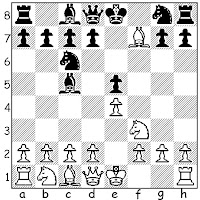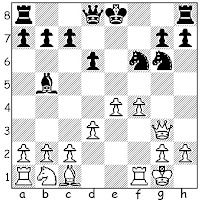It is said that "variety is the spice of life."
While a defender may know that Bill Wall is going to play the Jerome Gambit, 1.e4 e5 2.Nf3 Nc6 3.Bc4 Bc5 4.Bxf7+, he certainly will not know what variation Bill is going to spring upon him.
Wall,B - Guest2360621
PlayChess.com, 2013
1.e4 e5 2.Nf3 Nc6 3.Bc4 Bc5 4.Bxf7+
4...Kxf7 5.Nxe5+ Nxe5 6.Qh5+ Ng6
7.Qd5+ Ke8 8.Qxc5 d6 9.Qa3
This is the 6th different Queen move that Bill has played in this position. As he notes, " I try to make a new move every time when I can, to see what happens. The Queen can probably go anywhere as long as it is not taken or trapped."
Previously,
9.Qe3 - Wall,B - Parsom, Chess.com, 2010 (1-0, 25); Wall,B - HeHe, Chess.com, 2010 (1-0, 19); Wall,B - Reza,A, Chess.com, 2011 (1-0, 43); Wall,B - G3LC, PlayChess.com, 2011 (1-0, 22); Wall,B - Guest3312852, PlayChess.com, 2012 (1-0, 26);
9.Qh5 - Wall,B - Guest1475978, Sofia, 2013 (1-0, 28);
9.Qb5+ - Wall,B - Zhu,Y, Chess.com, 2011 (1-0, 19); Wall,B - Guest327668, PlayChess.com, 2012 (1-0, 22);
9.Qc4 - Wall,B - Royercordova, Chess.com, 2010 (1-0,18);
9.Qc3 - Wall,B - NFTM, FICS, 2010 (1-0, 22); Wall,B - Jaar,J, Chess.com, 2010 (1-0, 19).
For the record, Houdini 3, given 10 minutes "thought" for "infinite analysis", prefers 9.Qe3 (-.92), followed by 9.Qc3 (-1.17) and 9.Qb5+ (-1.29).
9...Nf6
The current game is the only one in The Database with this line. Bill suggests as an alternative 9...Qh4.
10.0-0 Be6
Not 10...Nxe4? because of 11.Qa4+.
11.f4 Bf7 12.f5 Ne5 13.d4 Nc6 14.d5
Bill suggests as well the alternative 14.Qd3
14...Ne5
15.Re1 Qd7 16.Bf4 Nc4 17.Qc3 b5 18.b3 Nb6 19.e5 dxe5 20.Bxe5
Threatening 21.Bxf6+, winning the knight. Now Black could keep things in balance with 20...Nxd5, but the threatened discovered check is too uncomfortable.
20...Kd8 21.Bxf6+ Kc8 22.Bxg7
A little stronger might be Bill's suggestion 22.Re7
22...Rg8 23.f6
Threatening Re7
23...Nxd5 24.Qd4 Qd6 25.c4 bxc4 26.bxc4 Nb6
A bit better was 26...Nb4, threatening ...Nc2, winning the Rook, although White is still better after 27.Qxd6 cxd6 28.Nc3.
27.Qxd6 cxd6 28.Re7
28...Bxc4 29.f7 Bxf7 30.Rxf7 Nd7
The advanced "Jerome pawn" has cost Black a piece.
31.a4 Kc7 32.a5 Kc6 33.Na3 Nc5 34.Nc2 Rab8 35.Nd4+ Kd5
Black threatens 36...Rxg7 37.Rxg7 Kxd4
36.Nf5 Ne4 37.Rxa7
Threatening Ne7+, forking King and Rook, but Black had enough here and resigned.
The fourth and final round of the Chess.com Italian Game thematic tournament has started, and there are four competitors: JoseSoza of Chile, vz721 of Russia, MarkHundleby1 of Canada, and yours truly, perrypawnpusher of the USA.
This presented as many as three more opportunities to defend the "honor" of the Jerome Gambit 1.e4 e5 2.Nf3 Nc6 3.Bc4 Bc5 4.Bxf7+, depending on how my opponents wished to defend.
So far, JoseSoza has declined the Jerome with 3...Be7, choosing the Hungarian Defense. This is his second "pass" after scoring two wins against my Gambit in rounds one and two.
On the other hand, vz721 has allowed it with 3...Bc5, and I was quick to sacrifice the Bishop! Let us hope this is not another example of Act in haste, Repent at leisure.
I have Black against MarkHundleby1 right now (defending against the Evans Gambit; alas, not the Evans Jerome Gambit), so the chance for a Jerome Gambit has to wait - unless he plays it against me!
The results, as for previous rounds, come what may, will be reported.
graphic by Jeff Bucchino, the Wizard of Draws
In a comment to the previous post on this blog, Quckturtle asked if I played the Jerome Gambit (1.e4 e5 2.Nf3 Nc6 3.Bc4 Bc5 4.Bxf7+) in over-the-board games.
I responded in the negative, mostly because I rarely play face-to-face games these days; instead, I play blitz and turn-based games on the internet.
Indeed, Eric Schiller, in his 2002 Gambit Chess Openings, referred to the Jerome Gambit as a "cyberspace gambit".
Yet, I wonder along with Quickturtle: who plays the Jerome Gambit in over-the-board play these days?
I have known for years that Jerome Gambit Gemeinde member Pete Banks ("blackburne") from Great Britain used to play it regularly - but, who else?
If you know someone, or if you play the Jerome otb yourself, please drop me a quick note (richardfkennedy@hotmail.com) or add a comment to this post, and let us know.
Here is the second kind of Jerome Gambit game that I encounter, where my opponent and I toss the game back and forth, and there are plenty of chances for me to take the advantage and run.
Sometimes, like in the following game, I do so.
perrypawnpusher - charlyeliot
blitz, FICS, 2013
1.e4 e5 2.Nf3 Nc6 3.Bc4 Bc5 4.Bxf7+
4...Kxf7 5.Nxe5+ Nxe5 6.Qh5+ Ng6 7.Qd5+ Ke8 8.Qxc5 d6 9.Qe3 Nf6
A familiar position - I've been here over 40 times, scoring over 80%.
10.0-0 Bd7 11.f4
Standard pawn play for me, but perhaps 11.d4 was a bit better.
11...Bb5
Or 11...Qe7 as in perrypawnpusher - peroneal, blitz, FICS, 2009 (½-½, 56).
12.d3 Ng4 13.Qg3 Nf6
The Knight returns home. From a different perspective, 13...Qh4, looking to exchange Queens, was playable. (Curiously, an almost identical position after 13...Qh4 occurred in Wall, B. - Guest3312852, Playchess.com, 2012 [1-0, 26], only Black's Bishop was on c4 and White's Knight was on c3.)
14.Nc3 Qd7
I occasionally use Houdini 3 to help me understand what is going on. Using "blunder check" set at 5 minutes per move, the program boiled the game down to the basics: 14...Bc6 15.f5 Nf8 16.d4 h5 17.Re1 Kf7 18.Bg5 Kg8 19.e5 dxe5 20.dxe5 h4 21.Qf4 Nd5 22.Qd2 Qd7 23.e6 Qd6 24.Nxd5 Qxd5 25.Qxd5 Bxd5 26.e7 Bc6 27.exf8Q+ Rxf8 28.Re5 Rh5 29.f6 gxf6 30.Bxf6 where White has a small, but perhaps not decisive edge.
Who knew?
15.f5
This move is okay, but I missed 15.e5 dxe5 16.fxe5 Nd5 17.e6!? which sets up the tactical shot 17...Qc6 18.Nxd5 Qxd5 19.c4 winning a piece.
15...Ne5 16.d4
This exchange sacrifice is not good.
16...Nh5
Trying to complicate things, when 16...Bxf1 17.dxe5 dxe5 18.Qxe5+ Kf7 19.Kxf1 Rhe8 20.Qf4 Qe7 would leave Black with an edge.
17.Qg5 Bxf1 18.Qxh5+
This allows Black's other Knight to escape directly, whereas Houdini 3's choice was: 18.dxe5 g6 19.e6 Qg7 20.Kxf1 c6 21.Kg1 h6 22.Qg4 Nf6 23.Qf3 Rg8 24.h3 Rd8 25.Ne2 gxf5 26.exf5 Ke7 27.g4 Nd5 28.c4 Nb4 with advantage to White.
18...Nf7 19.Kxf1 Qc6
The smoke is clearing, and White has two pawns for the exchange.
20.Be3 Qa6+ 21.Kg1 Qc6 22.e5 dxe5 23.dxe5 g6 24.fxg6
Stronger was 24.Qh3 gxf5 25.Rf1.
24...Qxg6 25.Qxg6
Exchanging favors. Black should have captured on g6 with the pawn, and White had a much better choice in 25.Qe2!?
25...hxg6 26.Bd4 Rh6 27.Nd5
There is still a fight going on. Black should now protect his c-pawn with his Rook, as his choice of moves allows another tactical shot (which I missed).
27...Kd7 28.Rd1
Instead, 28.e6+!? wins material.
28...Kc6 29.Nb4+ Kb5 30.Nd3 a6
More slipping and sliding.
31.Nf2
Missing a chance to show some cooperation among my pieces, winning material: 31.a4+ Kxa4 (31...Kc6 32.e6 Kd5 33.Nf4+ Ke4 34.exf7 Kxf4 35.Bc3 Rh7 36.Rf1+ Ke4 37.f8Q Rxf8 38.Rxf8 ) 32.b3+ Kb5 33.c4+ Kc6 34.e6 Nd8 35.Nb4+ Kd6 36.Bg7+ Kxe6 37.Bxh6.
31...Rd8 32.h3
And the game is about even.
32...Kc4 33.Bc3 Re8
Exchanging Rooks was the right idea. Now Black gives back the exchange, and White starts pushing things.
34.Ng4 Rh5 35.Nf6 Rd8 36.Rxd8 Nxd8 37.Nxh5 gxh5
38.Kf2 Ne6 39.Kg3 b5 40.Bd2 Kd5 41.Bf4 Nxf4 42.Kxf4 c5 43.g4 hxg4 44.hxg4 c4 45.g5 b4 46.g6 c3 47.b3 Ke6 48.g7 Kf7 49.Kf5 Kxg7
50.Ke6 Kf8 51.Kd7 a5 52.e6 Kg7 53.e7 Kf7 54.e8Q+ Kg7 55.Ke7 Kh7 56.Qf8 Kg6 57.Qf6+ Kh7 58.Qg5 Kh8 59.Kf7 a4 60.Qh6 checkmate
My most recent two Jerome Gambit games seem to illustrate the two classes of battle that I get enmeshed in.
Sometimes my opponent plays well, and there comes a time when I need to act decisively - or lose the game.
Sometimes the game has a multitude of complex alternatives - and the player who misses out on the last one drops the point.
First, and example of the first.
perrypawnpusher - BeeFiftyTwo
blitz, FICS, 2013
1.e4 e5 2.Nf3 Nc6 3.Bc4 Nf6 4.Nc3 Bc5 5.Bxf7+
The Italian Four Knights Jerome Gambit.
5...Kxf7 6.Nxe5+ Nxe5 7.d4 Bxd4 8.Qxd4 d6 9.0-0 h6
Transposing to the Semi-Italian Four Knights Jerome Gambit.
10.f4 Nc6 11.Qd3 Re8
I have reached this position 15 times before and each time played 12.Bd2, scoring 70%, which is about my result for the IFKJG, but not as good as my result in the S-IFKJG.
For some reason, I decided to try something different.
12.b3 Kg8 13.Bb2 Bg4 14.h3 Bh5 15.Rae1 Bf7 16.Nd5 Nxd5 17.exd5 Nb4
With only a pawn for my sacrificed piece, I needed some "cooperation" from my opponent, and here it is. The iron is hot.
If you had told me that Houdini now recommends 18.Qg3 Bg6 19.Qxg6 with advantage to White, I would not have argued (although I might have chuckled). I had looked at 18.Qg3, and was not afraid of Black returning a piece - I expected that instead he would play the logical follow-up to his Bishop maneuver, 18...g6.
In my calculations I missed the fact that 19.Qc3 would then be crushing - actually forcing a checkmate in no more than 8 moves!
18.Qc3 Qf6
The difference: had I first forced ...g7-g6, this would not have been playable.
19.Qxf6 gxf6 20.a3 Nxd5 21.c4 Ne3 22.Rf3 Nf5 23.Rxe8+ Rxe8 24.Bxf6 Re3 25.Kf2 Rxf3+ 26.Kxf3 d5
White's situation is not hopeless - my opponent was becoming short on time. A slim hope.
27.g4
Probably better was 27.c5
27...Nd6 28.c5 Nb5 29.a4 Na3 30.g5 hxg5 31.fxg5 Nc2 32.Ke2 d4 33.Kd3 Bxb3 34.Bxd4 Nxd4 35.Kxd4 Bxa4
At this point my only hope was the clock, but it was not to be. My opponent moved quickly on his 2-second increment... The rest of the game would only be relevant if I had won on time. Maybe not even then.
36.h4 Be8 37.Kc4 a6 38.Kb4 Kg7 39.h5 Bxh5 40.c6 b6 41.Kc4 Bf3 42.Kb4 Bxc6 43.Kc4 Kg6 44.Kb4 Kxg5 45.Kc4 Kf5 46.Kb4 Ke5 47.Kc4 a5 48.Kb3 b5 49.Kc3 Bd5 50.Kb2 b4 51.Kb1 a4 52.Kb2 a3+ 53.Kb1 b3 54.Ka1 b2+ 55.Kb1 Be4+ 56.Ka2 b1Q+ 57.Kxa3 Bd5 58.Ka4 c6 59.Ka5 Qb5 checkmate
I'm always up for a Jerome Gambit, if my opponent allows it.
Well - almost always. Sometimes my patience falters.
But that doesn't mean that I can't still play cheesy chess.
perrypawnpusher - kanidonara
blitz, FICS, 2013
1.e4 e5 2.Nf3 Nc6 3.Bc4 h6
Side-stepping the Jerome Gambit for the Semi-Italian Opening.
4.0-0
Hoping for 4...Bc5 and a chance at the Semi-Italian Jerome Gambit.
4...Nf6 5.Nc3
Okay. Looking for 5...Bc5 and the ability to play the Semi-Italian Four Knights Jerome Gambit.
5...a6
My opponent holds off on his ...Bc5. I've fussed about this before, in "Are We There Yet?"
6.d4
Giving up on the Jerome Gambit.
Previously I prevaricated with 6.a3 and then my opponents allowed me my wish by playing ...Bc5: perrypawnpusher - cinamon, blitz, FICS, 2010 (1-0, 28); and perrypawnpusher - Olito, blitz, FICS, 2011 (0-1, 35).
I also "passed" with 6.d3, getting a chance to sacrifice my Bishop as well, in perrypawnpusher - tschup, blitz, FICS, 2010 (0-1, 18)
Bill Wall played 6.a4 and scored with 6...Bd6 7.Bxf7+ Kxf7 8.Qe2 Re8 9.Qc4+ Kf8 10.Nh4 Ne7 11.d3 b6 12.f4 a5 13.fxe5 Bxe5 14.d4 d5 15.exd5 Bd6 16.Bxh6 gxh6 17.Rxf6+ Kg7 18.Raf1 Ba6 19.Nb5 Be5 20.dxe5 Qxd5 21.Qg4+ Kh7 22.Rf7+ Kh8 23.Qg7 checkmate, Wall,B - Kamyar,K, Chess.com, 2011.
6...exd4 7.Nxd4 Bc5
8.Be3
I suppose that I could have still tried 8.Bxf7+, (although there are no examples in The Database) but I wanted to play this not-very-deep "trappy" move, as it was easy to guess my opponent's routine response.
8...0-0
Routine, but trouble.
9.Nxc6 bxc6 10.Bxc5
My opponent resigned a few moves later.
Here are a couple of similar examples, by long-time Jerome Gambit Gemeinde member PlatinumKnight.
PlatinumKnight - strawks
blitz, FICS, 2005
1.e4 e5 2.Nf3 Nc6 3.Bc4 h6 4.d4 exd4 5.Nxd4 Bc5 6.Be3 Nf6 7.Nxc6 bxc6 8.Bxc5 Nxe4 9.Bxf7+ Kxf7 10.Qf3+ Nf6 11.Bd4 Qe7+ 12.Kd1 Re8 13.Qb3+ d5 14.Nd2 Qe2+ 15.Kc1 Qe1+ 16.Rxe1 Rxe1 checkmate
PlatinumKnight - warehouse
blitz, FICS, 2005
1.e4 e5 2.Nf3 Nc6 3.Bc4 h6 4.d4 exd4 5.Nxd4 Bc5 6.Be3 Nf6 7.Bxf7+ Kxf7 8.Nxc6 Bxe3 9.Nxd8+ Rxd8 10.0-0 Bg5 11.e5 Ng8 12.Qf3+ Ke6 13.Re1 c6 14.Nc3 b5 15.Ne4 Ne7 16.Nxg5+ hxg5 17.Qg4+ Kd5 18.Qxg5 g6 19.Rad1+ Kc5 20.e6+ Kb6 21.Qxe7 a5 22.Qxd8+ Kc5 23.e7 Bb7 24.Qxd7 Bc8 25.Qc7 Bf5 26.Re5+ Kb4 27.c3+ Ka4 28.Qxc6 Rb8 29.Rd4 checkmate
The following game can be looked at as a series of riddles posed to the "hero" (that would be me, I guess) on his way to an unexpected victory - isn't that the only kind of win for White that comes in the Jerome Gambit?
Sadly (for him), my opponent could not solve his own final riddle...
I have given game references for early in the play, to see how to deal with riddle #1 (7...Qe7, the Jerome Defense to the Jerome Gambit, by the way) and riddle #2 (9...Nh6), but after that you are largely on your own - as I was.
perrypawnpusher - Kleini
blitz, FICS, 2013
1.e4 e5 2.Nf3 Nc6 3.Bc4 Bc5 4.Bxf7+
4...Kxf7 5.Nxe5+ Nxe5 6.Qh5+ Kf8 7.Qxe5 Qe7 8.Qf4+
I would rather not exchange Queens at this point.
8...Qf6
The alternative 8...Nf6 is as old as two Jaeger,D - Jerome,A correspondence games from 1880, wins for Black in 14 and 40 moves.
At a faster time control, I have been more successful: perrypawnpusher - ERICOLSON, blitz, FICS, 2007 (1-0, 33);
perrypawnpusher - frencheng, 10 5 blitz, FICS, 2010 (½-½ , 31); perrypawnpusher - jonathankochems, blitz, FICS, 2010 (1-0, 39); and perrypawnpusher - Chesssafety, Chess.com, 2012 (1-0, 25).
9.Qg3
Not 9.Qxc7? Qxf2+ 10.Kd1 d6.
9...Nh6
An interesting novelty of questionable value.
Previously seen have been 9...d6 in Wall,B - Guest340293, Playchess.com, 2012 (1-0, 41), perrypawnpusher - JoseSoza, Chess.com, 2012 (0-1, 37), and Wall,B - Josti, Playchess.com, 2013 (1-0, 26); and 9...Bd6 in perrypawnpusher - molerat, blitz, FICS, 2010 (1-0, 23).
10.Nc3 d6 11.Nd5 Qf7 12.0-0 c6
13.Nc3
Houdini 3's solution to the riddle of this position is 13.d4!? The silicon superstar sees White drawing by repetition after 13...cxd5 14.dxc5 dxe4 (14...dxc5 15.Bxh6 gxh6 16.Qd6+ Kg7 17.Qg3+ etc.) 15.Bxh6 gxh6 16.Qxd6+ (16.f3!? is an interesting attempt for more, e.g. 16...e3 17.Rfe1 Bf5 18.Rxe3 Qf6 19.Qf4 Rg8 20.cxd6 ) Kg7 17.Qg3+ Qg6 18.Qc7+ Qf7 19.Qg3+, etc.
It's all a bit over my head. Okay, more than "a bit".
13...Be6 14.d3
Again, 14.d4!? seems to be the key to the position, 14...Bb4 15.a3 Bxc3 16.Qxd6+ Qe7 17.Qf4+ Kg8 18.bxc3 and Black's edge is minimal.
14...Qg6
15.Qxg6
By now the alternative (according to Houdini 3) should be predictable: 15.d4!? Bb4 16.a3 Bxc3 17.Qxd6+ Kg8 18.bxc3 Nf7 with a small edge to Black.
15...hxg6
White has two pawns for his sacrificed piece.
The Knight escapade that I started with my next move was a bad idea, and led to a lost position. I should have moved the piece to the Kingside with 15...Ne2.
16.Na4 Bd4 17.c3 Bf6 18.b3 b5 19.Nb2 Bxc3
20.Rb1 Ke7 21.Nd1 Bd4 22.Ne3 Ng4 23.h3 Nxe3 24.fxe3 Be5 25.d4 Bg3 26.Rf3 Bh4
Black's two Bishops are scary. He just has to be careful, and he can bring home the point.
Of course, that was true 20 moves ago, too.
27.Ba3 Rhf8 28.Rbf1 a5
I don't blame you if you didn't shout "He should have exchanged Rooks before playing that move!" I didn't realize that it was that critical, either.
29.Bxd6+
Exchanging Rooks, too, here is supposed to be stronger, according to Houdini 3. I was just glad to have a shot at bringing the game closer to equal.
29...Ke8
Wow. Surprised by my move, my opponent stumbles hard. That's blitz for you.
Instead, after 29...Kxd6 30.Rxf8 Ra7!? Houdini 3 believes Black's two Bishops balance out White's Rook and two extra pawns. Play would remain tricky, but if White can collect and/or exchange some pawns, he should be able to split the point.
30.Rxf8+ Black resigned
















































